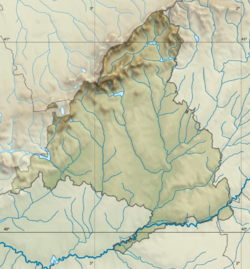Santorcaz
Santorcaz | |
|---|---|
 | |
| Coordinates: 40°28′29″N 3°13′48″W / 40.47472°N 3.23000°W | |
| Country | Spain |
| Autonomous community | Community of Madrid |
| Government | |
| • Mayor | Raúl Caraballo |
| Area | |
• Total | 28.14 km2 (10.86 sq mi) |
| Elevation | 878 m (2,881 ft) |
| Population (2018)[1] | |
• Total | 850 |
| • Density | 30/km2 (78/sq mi) |
| Demonym | Torcuatos |
| Time zone | UTC+1 (CET) |
| • Summer (DST) | UTC+2 (CEST) |
| Postal code | 28818 |
| Website | Official website |
Santorcaz is a town and municipality in the Community of Madrid, Spain.
Location
[edit]Santorcaz is located on the moors rising up to the left (southern) bank of the Henares. The thalweg of the main hydrographic feature of the municipality, the Anchuelo creek, marks the lowest altitude of the municipality (around 780 metres above sea level).[2]
History
[edit]
Located some metres north of the housing at the opposite side of the M-213 road,[3] the Llano de la Horca site hosts a Late Iron Age Carpetanian oppidum (3rd century-1st century BCE), built over an older Bronze Age occupation phase.[4]
In 1129, Santorcaz was donated along with other places attached to the land of Alcalá, to Archbishop Raymond of Toledo.[5] It was granted township in 1486.[6] The effects of the Succession War plunged the town into a dire state in 1706.[7] The town underwent French military occupation during the Peninsular War.[8]
The opening of the road from Madrid to the Royal Site of La Isabela passing near the town fostered some economic recovery after 1817.[9]
Sights include the church of San Torcuato and the annexed castle of Torremocha (14th century).
As of 2010, Santorcaz had a population of 822.
References
[edit]- ^ Municipal Register of Spain 2018. National Statistics Institute.
- ^ López-Muñiz Moragas 2009, pp. 221–222.
- ^ López-Muñiz Moragas 2009, p. 223.
- ^ Uzquiano, Paloma; D'Oronzo, Cosimo; Fiorentino, Girolamo; Ruiz-Zapata, Blanca; Gil-García, Ma. José; Ruiz-Zapatero, Gonzalo; Märtens, Gabriela; Contreras, Miguel; Baquedano, Enrique (2012). "Integrated archaeobotanical research into vegetation management and land use in El Llano de la Horca (Santorcaz, Madrid, central Spain)". Vegetation History and Archaeobotany. 21: 485–488. doi:10.1007/s00334-011-0340-0.
- ^ López-Muñiz Moragas, Gonzalo (2009). "Santorcaz". Arquitectura y Desarrollo Urbano. Comunidad de Madrid (PDF). Vol. XVII. Zona Este. p. 224. ISBN 978-84-451-3211-1.
- ^ López-Muñiz Moragas 2009, p. 225.
- ^ López-Muñiz Moragas 2009, p. 228.
- ^ López-Muñiz Moragas 2009, pp. 230–231.
- ^ López-Muñiz Moragas 2009, p. 231.




